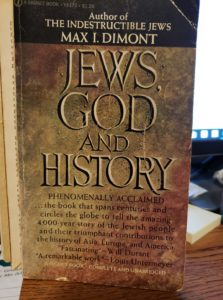Sometimes I pick up a used book and place it in my reading pile. Years may go by before I pick it up and read it. I don’t know how many times I never get to a book, or it will be years before I’m looking for something to read, dig deep in my pile, find something, and decide “This is the one for right now.”

That was the case with Jews, God and History by Max I Dimont. When I pulled this from the pile, I found no label on it. Inside was a very faded receipt. I can just make out that I the receipt says I bought three books at Helping Hands, a local thrift store with a great books section, paid a total of $2.00 cash for all three. The purchase was at 10:42 a.m., but the date is too faded to read.
This is a mass-market paperback with cheap binding. While I was reading it, it fell apart into two sections. So much for such books printed in 1962.
This was an informative book. Dimont is a skillful writer. He gives much information, not statistics and data, but sweeping narrative about the Jews throughout over four millennia: where they were, what influenced them, who they influenced, what their motivations were. In 421 pages of 10-point font, Dimont gives a comprehensive documentation of this amazing people.
I have a couple of criticisms of the book, however. By the time I was done with it (two months elapsed between my starting and finishing it), I had pretty well forgotten what had come at the beginning. In other words, while I was impressed as I read, the writing didn’t stick with me. I sometimes, when I finish a book, go back and re-read the Introduction to see if the writer achieved whatever goals were stated there. In this case I haven’t yet done that, and don’t think I will.
My other criticism is that the book is totally unsourced. Along with the information given, Dimont makes sweeping judgments on the why of the history, not just the what. Here’s an example of one of those:
Like a Freudian libido flowing through the unconscious, attaching itself to previous psychic experiences, the Haskala flowed through the body of Judaism, attaching itself to former Jewish values and creating new ones. It attached itself to Hebrew and Yiddish, creating a new literature. It attached itself to Jewish religion and created Jewish existentialism. It attached itself to politics and created Zionism. Zionism fused the Jews in Eastern and Western Europe with the Jews in the United States and created the new State of Israel. This vast transformation and fusion began with a few Talmudic students fighting the Hasidists, who were preaching a return to primitivism of feeling as a way of relating themselves with God.
To me, such broad statements need to be sourced. Where did these ideas come from? Are they the author’s interpretation? They are stated as fact when they seem to be opinion. I would have liked it to be clearer.
Those criticisms aside, I thoroughly enjoyed the book, if being maddened at it a few times. I certainly don’t regret taking time to read it. It will not, however, have a permanent place on my bookshelf. I don’t think it would even if it hadn’t fallen apart.
However, while the book is unsourced, it does have an extensive Bibliography. Pages and pages of published works are listed, many of them look inviting. I’m tempted to tear these pages from the weak binding and find a permanent place for them in my library, being a list of potentially valuable sources for future research. The only thing making me think I should do that is the thought: How will I ever find those pages again?